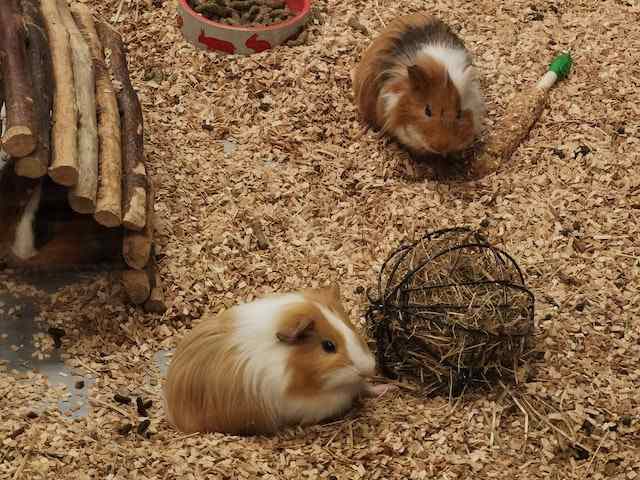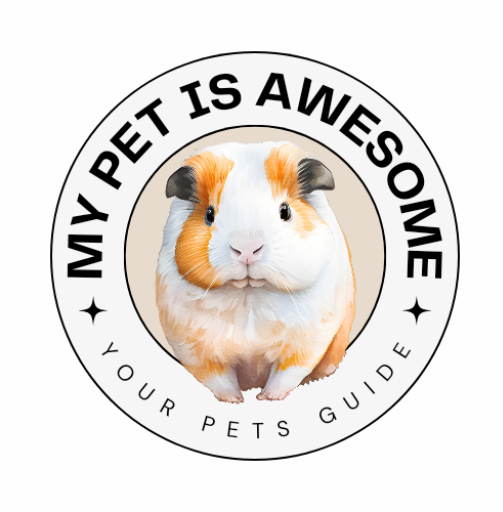Welcome to the Exciting World of Guinea Pig Parenting!
Congratulations on your decision to welcome a cute guinea pig into your home!
As a first-time guinea pig owner, you’re embarking on a journey filled with squeaks, cuddles, and endless cuteness. To ensure your new furry friend feels right at home from the start, I’ve curated this Ultimate Guinea Pig Supplies List just for you.
Whether you’re preparing to bring home your very first guinea pig or expanding your guinea pig family, this comprehensive guide will walk you through all the essentials you need to create a cozy and joyful haven for your petite companion.
Let’s dive in!

What supplies do I need to have a guinea pig?
- A cage mate.
- Hay (Timothy/Orchard Grass/Botanical/Oat Hay.)
- Hay rack
- Water bottle (one per cavy, min 12 oz.)
- Pellets
- Vegetables, greens, fruit
- Treats
- Food Bowls
- Toys
- chew toys from wood or compressed hay
- Cage or large fenced habitat (min cage of 7.5 square feet / 0.7 sq m for 2 piggies)
- Cage cleaner (white vinegar or commercial)
- Small dustpan and brush
- Unscented laundry detergent for reusable bedding
- Playpen (optional) for safe floor time
- Guinea pig’s house
- Fleece, paper or hemp disposable or reusable bedding
- Warm bed for winter (optional)
- Nail clippers
- Comb (for long haired breeds)
- Scissors (for long haired breeds)
- Vitamin C Supplement
- Emergency savings or pet insurance
- Vet clinic contact numbers
- First-aid kit
- Scale
- Small carrier for travel
- Tunnels, hiding places
- Guinea pig shampoo
- Coconut oil (for hairless, skinny pigs)
- For outdoor – wooden hutch
- Book on guinea pigs or this one

First-aid kit for guinea pigs
- Critical care
- Liquid vitamin C
- Styptic powder or flour
- Syringes
- Sterile Saline Solution
- Antiseptic Solution
- Baby Gas Drops (Simethicone)
- Non-stick Bandages
- Q-tips
- Digital Thermometer

FAQ
Are guinea pigs easy to take care of?
Absolutely! Guinea pigs are widely considered as easy pets to care for, making them a popular choice for families and people looking for smaller pet.
One of the reasons for their ease of care is their size; being small animals, they don’t require extensive living spaces, making them suitable for homes with limited room.
Their social nature is another plus; guinea pigs thrive in the company of their kind, and having a pair or a small group provides them with companionship and mental stimulation.
Dietary Simplicity: Guinea pigs have straightforward dietary needs, primarily consisting of high-quality hay, fresh vegetables, guinea pig pellets, and access to clean water. Their diet is easy to manage and doesn’t involve complex feeding routines.
Low-Maintenance Grooming: In terms of grooming, guinea pigs are generally clean animals that groom themselves regularly. While they might need occasional brushing, nail trimming, and baths, these grooming tasks are manageable and not overly time-consuming.
Friendly Temperament:
Guinea pigs are known for their gentle and docile nature, making them suitable pets for families, especially those with children. Their friendly disposition means they are less likely to display aggressive behavior compared to some other small animals.
Simple Entertainment Needs: While they do enjoy interaction and playtime outside of their cage, guinea pigs are content with basic toys and activities. They don’t require elaborate setups for entertainment, adding to the ease of caring for them.
While guinea pigs are relatively easy to care for, it’s important to remember that they still require commitment, attention, and proper care.
Regular cage cleaning, social interaction, veterinary check-ups, and a balanced diet are essential for their well-being.
Also, guinea pigs can live several years (typically 5-7 years or even longer), so potential owners should be prepared for the long-term commitment before getting a guinea pig as a pet.
How do you set up a guinea pig cage for beginners?
Setting up a guinea pig cage for beginners involves creating a comfortable, safe, and stimulating environment for your new pets.
Here’s a step-by-step guide to help you set up the perfect guinea pig habitat:
1. Choose the Right Cage:
Select a spacious cage made of a safe, chew-proof material like metal with a solid bottom to prevent foot injuries.
Guinea pigs need room to roam, so aim for a cage size of at least 7.5 square feet for one or two guinea pigs.
2. Provide Bedding:
Line the cage floor with a layer of safe bedding material such as fleece liners, aspen shavings, or paper-based bedding.
Avoid cedar or pine bedding, as the aromatic oils can be harmful to guinea pigs.
3. Add Hideouts and Shelter:
Place hideouts or small shelters inside the cage. Guinea pigs like having private spaces where they can feel secure.
You can use commercial guinea pig igloos or create DIY hideouts using cozy, washable materials.
4. Offer a Food Bowl and Water Bottle:
Provide heavy, non-tip food dishes to prevent spillage. Stainless steel or ceramic dishes are good choices.
Attach a drip-proof water bottle to the cage, ensuring a fresh supply of water at all times.
5. Introduce Chew Toys:
Guinea pigs need to chew to keep their teeth healthy. Offer safe chew toys made of wood or natural materials.
Wooden blocks, tunnels, and hay-filled toys are excellent options.
6. Include a Hay Rack:
Provide a hay rack or hay feeder to encourage guinea pigs to eat hay. Hay is a crucial part of their diet and aids in digestion.
Fresh hay should be available at all times, as it also serves as a cozy bedding option.
7. Create a Play Area:
Designate an out-of-cage play area where guinea pigs can explore and exercise under supervision.
Use a playpen or create a secure space with barriers to prevent them from wandering off.
8. Maintain Cleanliness:
Establish a cleaning routine to keep the cage odor-free. Spot-clean daily, removing soiled bedding and uneaten food.
Perform a thorough cleaning at least once a week, replacing all bedding and cleaning the cage and accessories.
9. Social Interaction:
Guinea pigs are social animals and thrive in pairs or small groups. Consider adopting at least two guinea pigs of the same gender to provide companionship.
Spend time with your guinea pigs daily, offering gentle interactions and treats to build trust and bond with them.
I remind you that each guinea pig’s personality and preferences vary, so observe their behaviors and adjust their living space accordingly to cater to their specific needs.
